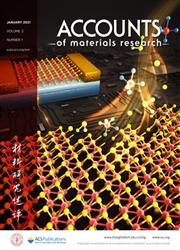2D Perovskite Oxides toward High-Performance Ultraviolet Photodetection
IF 14
Q1 CHEMISTRY, MULTIDISCIPLINARY
引用次数: 0
Abstract
Ultraviolet (UV) light, spanning wavelengths from 10 to 400 nm, is ubiquitous in military, livelihood, and scientific domains. Accurate UV photodetection is therefore essential for monitoring environmental radiation, safeguarding human health, and advancing technological applications in fields such as aerospace, medical science, and ecology. The fabrication of high-performance UV photodetection devices fundamentally depends on the development of high-sensitivity UV photosensitive materials. The evolution of UV photodetection materials has progressed from early wide-bandgap semiconductors like ZnS and ZnSe to third-generation semiconductors such as GaN and Ga2O3, and most recently to two-dimensional (2D) wide-bandgap materials that combine exceptional optoelectronic properties with compelling physicochemical properties. Among these, 2D perovskite oxides stand out due to their prominent advantages for UV detection. First, this large family of materials generally features wide bandgaps, strong UV absorption, and high spectral selectivity. Second, the tunable bandgaps of 2D perovskite oxides enable precise detection at specific wavelengths. Third, their excellent processability and flexibility facilitate feasible integration into devices, making them promising candidates for flexible photodetectors. Furthermore, 2D perovskite oxides boast other properties such as high stability, dielectricity, ferroelectricity, and biocompatibility. These characteristics have promoted the blossoming of 2D perovskite oxides for high-performance UV photodetection and are poised to expand their applications in novel functional optoelectronics.

面向高性能紫外光探测的二维钙钛矿氧化物
紫外线(UV)的波长从10到400纳米,在军事、生活和科学领域无处不在。因此,精确的紫外光探测对于监测环境辐射、保障人类健康以及推进航空航天、医学和生态等领域的技术应用至关重要。高性能紫外光探测器件的制造从根本上依赖于高灵敏度紫外光敏材料的发展。紫外光探测材料的发展已经从早期的宽带隙半导体(如ZnS和ZnSe)发展到第三代半导体(如GaN和Ga2O3),以及最近的二维(2D)宽带隙材料,这些材料结合了卓越的光电性能和引人注目的物理化学性能。其中,二维钙钛矿氧化物因其在紫外检测方面的突出优势而脱颖而出。首先,这一大类材料通常具有宽带隙,强紫外吸收和高光谱选择性。其次,二维钙钛矿氧化物的可调带隙使得可以在特定波长下进行精确检测。第三,它们优异的可加工性和灵活性有助于集成到器件中,使它们成为柔性光电探测器的有希望的候选者。此外,二维钙钛矿氧化物还具有其他特性,如高稳定性、介电性、铁电性和生物相容性。这些特性促进了用于高性能紫外光探测的二维钙钛矿氧化物的蓬勃发展,并准备扩大其在新型功能光电子学中的应用。
本文章由计算机程序翻译,如有差异,请以英文原文为准。
求助全文
约1分钟内获得全文
求助全文

 求助内容:
求助内容: 应助结果提醒方式:
应助结果提醒方式:


